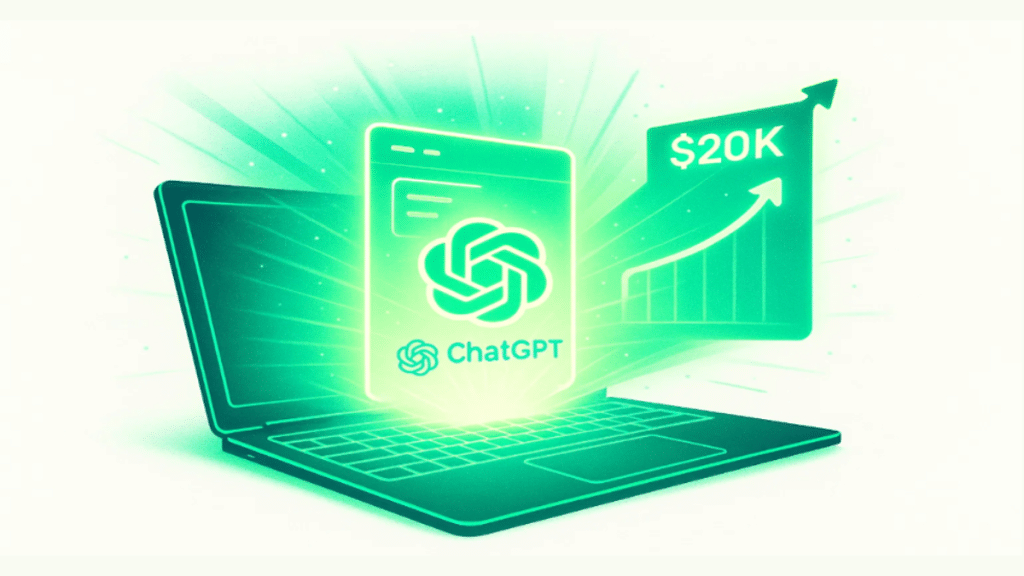ChatGPT wasn’t supposed to be his co-founder. But for this solo developer, who juggled freelance gigs and side projects, Artificial Intelligence ended up being the one thing that turned a messy weekend prototype into a working SaaS. He had tried every cloud software, every project module, even Perplexity AI for research, but nothing cut through his chaos. With one focused prompt, the chatbot rewrote his weekend. By Monday, he had something real to show—and a week later, a $20K client signed.
The Founder Who Never Finished Projects
He had ideas every month.
Dashboards. Automations. Little Chrome extensions.
But execution? Always stuck.
- Code repos half-built.
- Designs left hanging in Figma.
- Deadlines missed until clients stopped asking.
Like most solo founders, he blamed discipline. In reality, he lacked structure. His weekend “prototype sprint” usually ended in overthinking.
That Friday night, tired of seeing another repo die, he typed into ChatGPT:
“Take this prototype idea. Write a full app roadmap: features, API endpoints, user flows, stretch goals. Make it buildable in 48 hours.”
ChatGPT Drew the Plan Like a CTO
The output wasn’t vague inspiration. It was a structured doc:
- MVP core: authentication, dashboard, client form submission.
- Day 1 sprint: backend scaffolding + login.
- Day 2 sprint: dashboard UI + integration.
- Stretch goals: analytics, notifications.
For the first time, he had a real build order. Instead of tinkering, he had a sprint.
Building With AI as a Silent Partner
He kept pushing. Saturday morning, he asked:
“Generate Node.js code for a minimal API with JWT authentication and three routes: create, fetch, delete.”
ChatGPT produced clean scaffolding. He pasted it into VS Code, fixed a few errors, and ran it.
It worked.
By Saturday night, the app had login and a dashboard shell. Sunday morning, he moved to frontend:
“Write a React component for a dashboard card with stats and a CTA button.”
Copy-paste, minor edits, live preview.
By Sunday night, the prototype wasn’t a sketch anymore. It was a working SaaS.
Why This Weekend Was Different
He compared it to his old workflow:
| Step | Old Way | With ChatGPT |
| Roadmap | Scribbles in Notion | Structured sprint |
| Backend | 3 days of docs | 30 min prompt |
| Frontend | Endless trial & error | Ready React draft |
| Delivery | Weeks later | 48 hours |
The key wasn’t speed alone. It was order. Deadlines stopped being vague. They turned into sprints.
Chatronix: The Multi-Model Shortcut
He didn’t stop with ChatGPT. By Monday, he needed polish—client emails, competitor research, and clean documentation. That meant Claude, Gemini, even Perplexity AI. Switching tabs killed momentum again.
That’s when he tried Top AI workspace for prompt engineering.
Inside Chatronix, the build cycle felt different:
- Six models in one chat: GPT-5, ChatGPT, Claude, Gemini, Grok, Perplexity AI.
- 10 free queries to test workflows without paying.
- Turbo mode with One Perfect Answer: merged outputs from all six into one usable draft.
- Side-by-side comparisons showed instantly which model’s code or copy was sharper.
| Task | Old Workflow | Inside Chatronix |
| Client email | Manual draft | Claude polish |
| Competitive scan | Google dive | Gemini summary |
| API doc | Messy notes | Turbo mode, merged |
| Sprint setup | Sticky notes | Saved prompt stack |
Instead of juggling tabs, he ran everything in one cockpit.
Bonus Prompt That Closed His First $20K Client
The line that sealed it came a week later:
“Write a one-page client proposal for this app. Include problem, solution, 3 features, timeline, and pricing. Keep tone confident but concise.”
He dropped it into Chatronix Turbo. The merged proposal read like it came from a seasoned agency. He sent it on Wednesday. The client signed on Friday.
$20K. From a weekend prototype.
What Changed for Him as a Founder
The win wasn’t luck. It was repeatability.
- Every idea could be structured in hours.
- Code scaffolding stopped eating weeks.
- Proposals sounded professional on the first draft.
He didn’t hire a co-founder. He built one inside prompts.
Why This Story Matters
For solo developers and early founders, the graveyard of half-finished prototypes is endless. ChatGPT turned one of those into a working app. Chatronix kept it sustainable, blending six models into one workflow.
The real difference wasn’t AI hype. It was execution.
Final Thought
He didn’t suddenly get disciplined. He didn’t find new funding.
He just let ChatGPT organize his weekend into sprints.
He let Chatronix merge six voices into one plan.
And for the first time, a prototype wasn’t abandoned—it closed a client.
Because the real productivity upgrade isn’t working harder. It’s building smarter.
